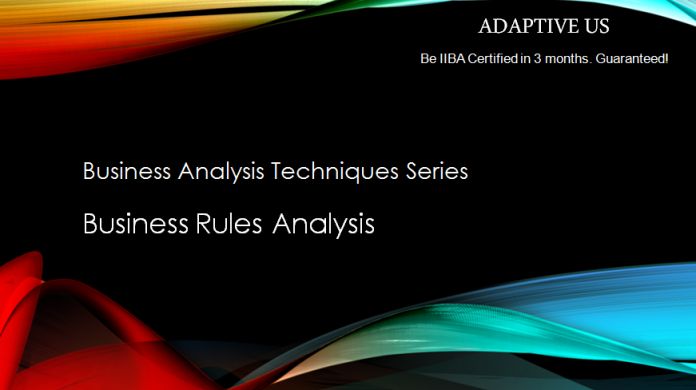Business Rules Analysis
Business Analysis Techniques Series. Business policies dictate actions of an enterprise and people in it by broadly controlling, influencing, or regulating them. Business rules serve as criteria for guiding behavior and making decisions in a specific, testable manner.
Business rules analysis identifies, expresses, validates, refines, and organizes business rules. Rules may be explicit or tacit (implicit). Requires a defined glossary. Usually expressed as decision tables or decision trees (flow chart).
Business rules should be:
- Use business terminology for validation.
- Documented independently from enforcement.
- Stated in declarative format at atomic level.
- Maintained in a manner enabling monitoring and adaptation as they change.
- Check out the “ Business Analyst Certification Training” article.
There are 2 types of business rules:
Type 1 – Definitional rules
Represent operational knowledge of organization. Prescribe how information may be derived, inferred or calculated. For example, Gross margin = Revenue – Variable cost of production. These rules can be misapplied but cannot be violated.
Type 2 – Behavioral rules
Behavioral rules guide actions of stakeholders which may be violated. Take precautions in the solutions to prevent violations. Example, “No customer should be provided a credit period of more than 30 days.” These rules can be violated.
Strengths
- An enterprise-wide rules engine can assist in quick implementation of rules changes.
- Centralized rules repository enable reuse.
- Allows organizations to make changes to policies without changing processes.
Limitations
-
- When combined, rules can be lengthy, inconsistent or produce unanticipated results.
- Poorly defined vocabulary can result in inaccurate or contradictory business rules.
Worked out Example:
Let us learn how business rules are developed by means of an example. Governance, Risk and Compliance (GRC) management system is developed for the IT and ITES domain. The primary objective of GRC management system is to help companies implement Governance, Quality, and Information Security Management Systems in an integrated manner. It has various features, one of which is to plan and track projects and programs using standards such as CMMI, ISO 9001, and ISO 27001 etc. Through this example let us try to understand some of the business rules for the schedule management module of Governance, Risk and Compliance (GRC) management system.
| Rule # | Module | Rule description |
| 10001 | Schedule | Planned Effort be Null or Greater than 0. |
| 10002 | Schedule | Planned effort shall be editable till base lined. |
| 10003 | Schedule | Parent task cannot be closed if any of child tasks are open. |
| 10004 | Schedule | Schedule Resources Child task start date cannot be less parent start date. |
| 10005 | Schedule | Schedule Resources Child task end date cannot be more than parent end date. |
| 10006 | Schedule | Schedule Resources Total effort for child tasks cannot be more than parent effort. |
| 10007 | Schedule | Schedule Resources – If Re-planned Start Dates and End Dates are blank, make it same as Planned Start Date and End Date. |
| 10008 | Schedule | Schedule Resources – Update Actual Start Date (if it is blank), once a resource adds effort in time sheet. |
| 10009 | Schedule | Schedule Resources – Planned effort, re-planned effort and actual effort must be > 0. |
| 10010 | Schedule | For child tasks – Child task start date cannot be less parent start date. |
| 10011 | Schedule | For child tasks – Child task end date cannot be more than parent end date. |
| 10012 | Schedule | For child tasks – Total effort for child tasks cannot be more than parent effort. |
Business policies and rules guide the day-to-day operation of the business and its processes and shape operational business decisions. Business rules should be captured, clearly written, validated with stakeholders, refined and organized properly for effective management and reuse. Business rules are largely classified into definitional or behavioral types. The examples shown above are definitional rules as they represent operational knowledge. Behavioral rules revolve around the behavior of the people.
Clearly defining and managing rules are essential for reusing business rules as well as ensuring smooth functioning of operations. However, if they are poorly defined and organized, it can result in inaccurate and contradictory rules.









